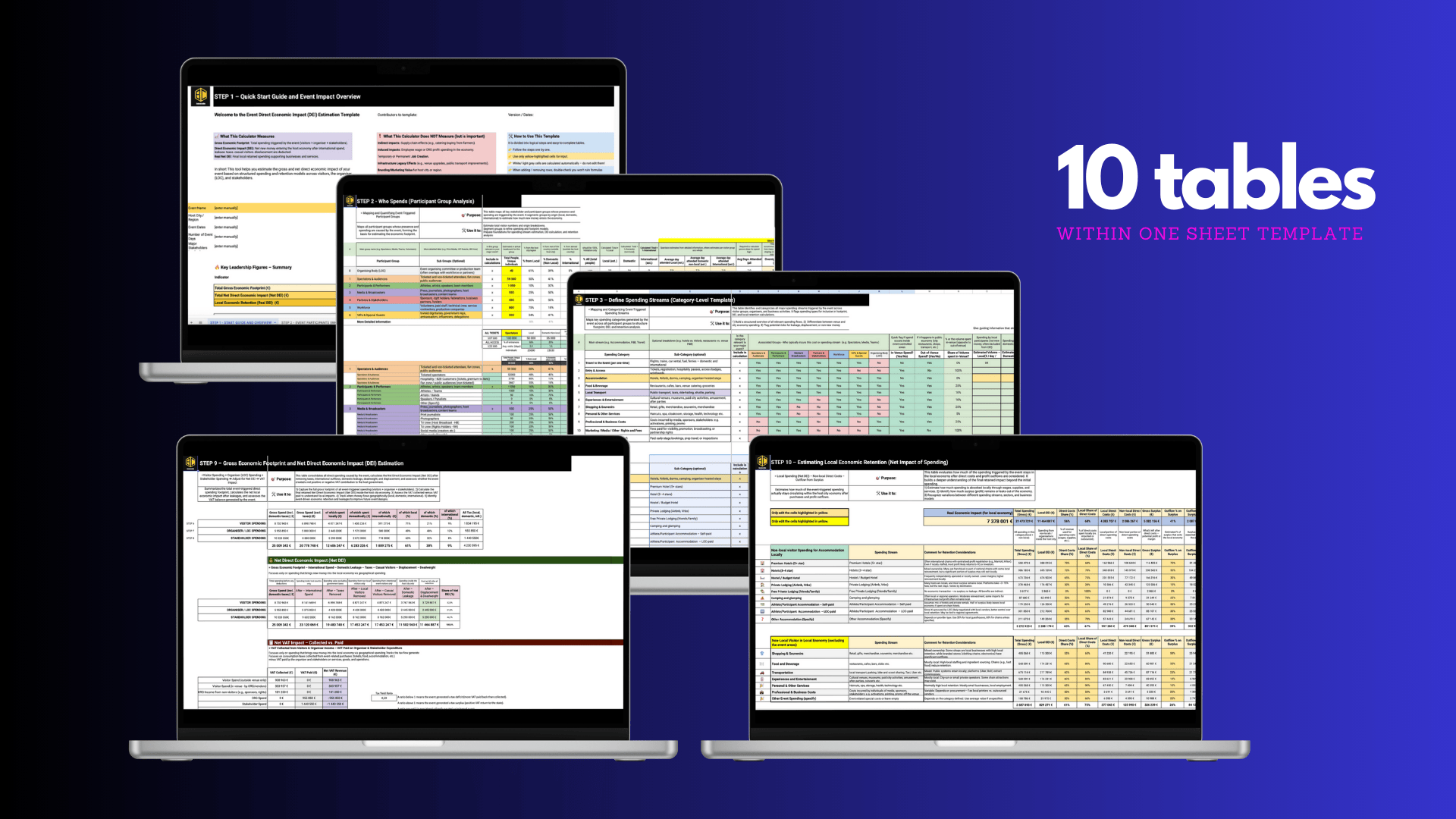
Simple 9-Step Real Major Event Economic Impact
Show the real return for your city and community.
Host cities and major event organisers usually report total spend — but that alone doesn’t show what stayed and helped local jobs, businesses, and tax income grow. This 9-step method breaks it down: who spent, where it went, what leaked out, and what truly stayed local. Estimate before your event. Check after. Prove what really came home.
What Most major event economic impact Estimates Miss
The standard Economic Impact Estimation approach looks good on paper: add up what visitors spent, multiply by how many came, then call it “economic impact.”
It’s tidy. It’s accepted. It makes headlines. But it hides the real story.
Spending inside a city is not the same as spending staying in the city. Much of that money leaks out — to chains, platforms, or outside owners.
What doesn’t stay can’t create local jobs, pay wages, or build capacity.
One transaction is just spending.
Only when money stays, circulates again, and supports local people
— that’s real major event economic impact.
And this what we estimate with my simple 9-Step Real Major Event Economic Impact Model.
Real Event Economic Impacts: What We Think We Know vs. What We Need to Know by Jesse Kiuru, Eventpreneur

9 Steps to Include in Major Event Economic Impact Estimates
Map who spends
Identify visitor and participant groups by origin (local, national, international).Define where they spend
List key spending categories for each group, such as accommodation, food, transport.Estimate daily spend
Set an average daily spend per group and category.Calculate gross visitor spend
Multiply daily spend by total person-days.Filter the spend
Deduct local visitors, usual tourists, leakage, displacement, and VAT.Add organiser spend
Estimate the organiser’s net spend with local suppliers, minus any local revenue.Add partner inflows
Include non-local flows from sponsors, media, production, and services.Calculate net direct impact
Sum the filtered spending to get Net Direct Economic Impact.Estimate local retention
Apply retention rates to show how much actually stays in the local economy.
-
“An event’s direct economic impact is defined as the amount of additional expenditure (i.e. new money) generated within a specific area as a consequence of staging it.”
That’s an example of the standard definition.
But here’s the real question:
🔍 “How much of that money actually stayed in the city — and helped local businesses, workers, and communities grow stronger?”
Traditional impact estimates rarely answer that
-
Because if we settle for reporting the Direct Economic Impact traditionally:
We risk overpromising and under-delivering to cities and taxpayers.
We create nice-looking numbers without showing real value.
We miss the chance to learn and improve from one event to the next.
If we estimate direct economic impacts more deeper:
We can build stronger cases for funding.
We can design smarter events that create real local benefits.
We can show real growth, not just temporary spending.
In my opinion.
Measuring accurately isn’t bureaucracy.
It’s a great piece of strategy.
-
Problem 1:
It counts money spent — not money kept.
The traditional method assumes:
“If someone spends money in the city, the city benefits.”
But that’s not how it really works completely.
Problem 2:
It stops at the first spend — and ignores what happens next.
But it doesn’t ask:
Did the local business reinvest that money?
Did it pay local workers, who then spent their wages locally?
Did it lead to upgrades, new hires, better services?
Without these next steps, spending is just a one-time event — not real economic growth.
Problem 3:
It multiplies what might already be gone.
Many economic impact reports show big numbers from "indirect" and "induced" effects.
Sounds great.
But here’s the catch:
If most of the original spending leaked out —(to chain hotels, global apps, HQs outside the city)— then there’s almost nothing left to circulate or multiply.
They’re multiplying an empty base.
-
Cities and organisers should not just need a headline number.
They would need to understand the full flow — from global footprint to local growth:
What was the total economic footprint? 🌍 (Total event-driven spending — local, national, and international — by visitors, organisers, other stakeholders)
How much of that was spent inside the host economy?💸 (New money entering the local city or region)
How much was retained by local people and businesses? 🔒 (What stayed — not just what passed through)
That’s what matters.
That’s what our Event Direct Economic Impact (DEI) Estimation model reveals — clearly and step-by-step.
It gives keys to unlock the last question.
4. What happened after the money landed? 🔁 (Did it circulate again? Was it reinvested, used to hire, or build long-term capacity?)
That’s what drives real, lasting growth
-
Here’s the simple logic, how cities and local economies captures (should capture) the value of major events:
↳ Event generate spending by visitors, organisers and other stakeholders
↳ Event brings new money into the city
↳ Local economy captures a share of it (retention)
↳ That money is re-spent, invested, used to hire
↳ Real growth: jobs, capacity, taxes, upgrades
↳ City and businesses reinvest in services, infrastructure, tourism
↳ The region becomes stronger, more competitive
↳ Long-term economic benefit and growth
So yes — retention leads to growth.
But only when the system can first capture, then reuse, and later multiply the value locally.
-
Stop asking:
“How much did people spend?”
Instead.
Start asking:
“How much stayed — and what grew from it?”
That’s the difference between spending and impact.
That’s what our Event Direct Economic Impact (DEI) Estimation model aims to.
It’s a logical tool and template to solve the pattern behind local economic growth - through major events.
Clearly and step-by-step.
-
Total Gross Economic Footprint (€)
Total Net Direct Economic Impact (Net DEI) (€)
Local Economic Retention (Real DEI) (E)
Total Number of Event Visits
Total Unique Event Visitors
Visitor Gross Spend (€)
Organiser Gross Spend (€)
Stakeholder Gross Spend (€)
Local Gross Spending (€) (excl. tax)
Domestic Gross Spending (€) (excl. tax)
International Gross Spending (€) (excl. tax)
Tax Collected from Visitor and Organiser Income (€)
Tax Paid by Organiser and Stakeholders (€)
Net VAT Position / Tax Yield Ratio
Total Visitor Spending for Accommodation (€)
Total Visitor Spending in Event Areas (ORG) (€)
Total Visitor Spending in Local Economy (off-the-venue) (€)
Total Visitor Spending Getting to/from Host City (€)
Average Spend per Unique Visitor (€)
Average Daily Spend per Visitor (€)
And much more details to share with ownership, stakeholders, or media
Guides and Templates for Estimating Major Event Economic Impact
-

Real Major Event Economic Impact Calculator (Google SHEET)
Full 9-step event impact and retention logic — 10 linked tables ready to use. Focus on what stays, not just what’s spent — no guesswork. Highly recommended for all major event hosts and organisers.
-

Complete Guide for estimating major event economic impact (Notion template)
Build your own event economic impact calculator step by step — all logic explained. Follow clear instructions to estimate, filter, and prove major event real economic impact.
-

Simple Event Impact Calculator (Microsoft Excel)
Quick traditional event economic impact estimate template for events — 4 core tables. Use standard direct spending logic with easy inputs.
Support for Estimating Real Major Event Economic Impact
With 20+ years working alongside host cities and organisers I help you see and show the real numbers behind your event.
Here’s how you can get started and get support:
✅ Complete Guide (Notion)
A step-by-step Notion guide to build your own calculator — clear instructions, filters, and logic to move from spending to real local impact.
✅ 9-Step Real Economic Impact Calculator
A ready-to-use spreadsheet with nine structured tables — follow the flow, fill in your data, and reveal what stays.
✅ Traditional Direct Impact Calculators
Simple models for quick spending estimates — works well for smaller events that don’t need full retention analysis.
✅ 1:1 Consulting
Work with me directly to set up your model, stress-test your assumptions, or check your final figures.
✅ Full Major Event Economic Impact Report
Hand over the numbers — I’ll run the model, test the data, and deliver a clear, defensible report you can share with decision-makers and the public.

Who I am to help You?
I am Jesse Kiuru. A straight-forward-thinking event professional with over 20 years of experience in organizing events.
I’ve gathered all my insights, processes, and experience into one comprehensive guide—so you can use the same tools I’ve refined over decades.
